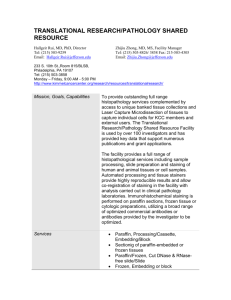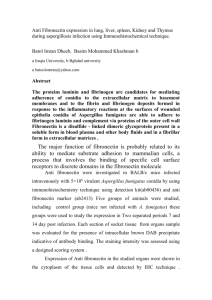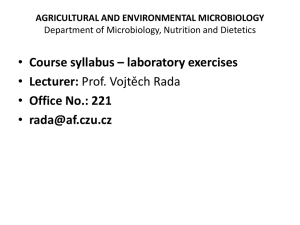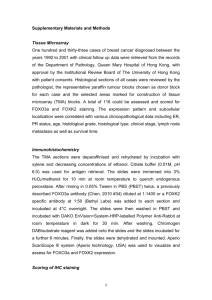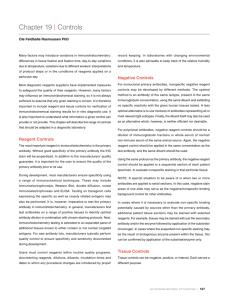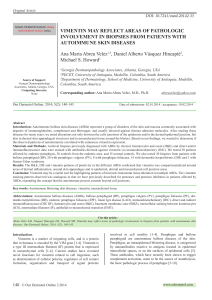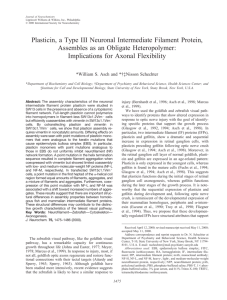Supplementary Material (doc 46K)
advertisement
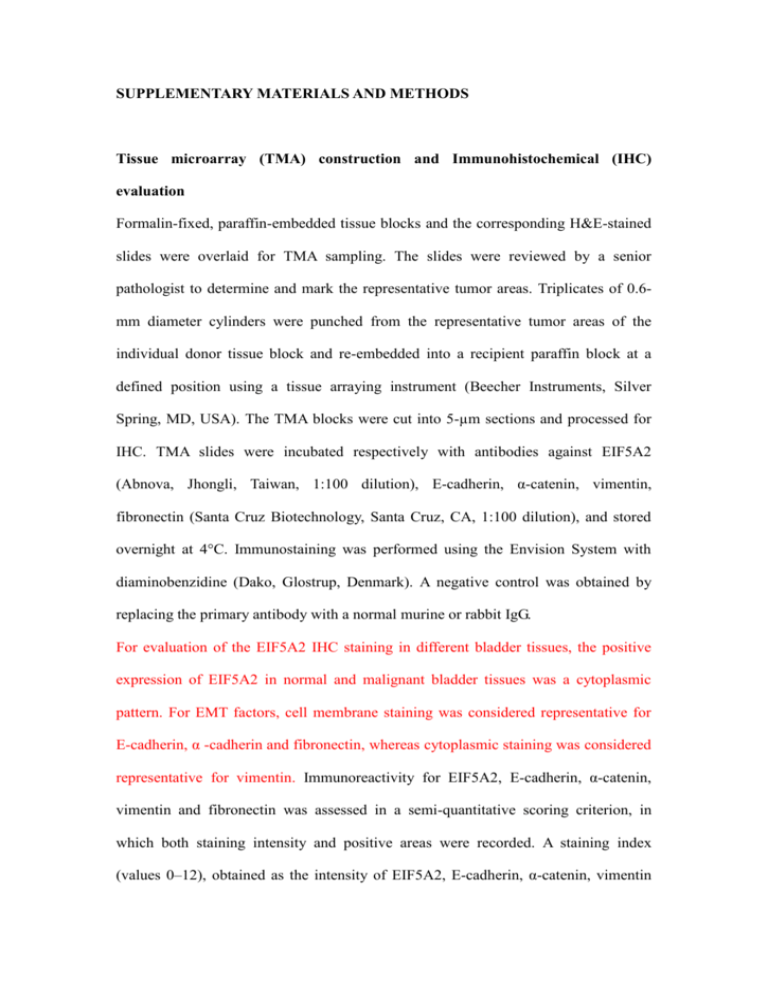
SUPPLEMENTARY MATERIALS AND METHODS Tissue microarray (TMA) construction and Immunohistochemical (IHC) evaluation Formalin-fixed, paraffin-embedded tissue blocks and the corresponding H&E-stained slides were overlaid for TMA sampling. The slides were reviewed by a senior pathologist to determine and mark the representative tumor areas. Triplicates of 0.6mm diameter cylinders were punched from the representative tumor areas of the individual donor tissue block and re-embedded into a recipient paraffin block at a defined position using a tissue arraying instrument (Beecher Instruments, Silver Spring, MD, USA). The TMA blocks were cut into 5-µm sections and processed for IHC. TMA slides were incubated respectively with antibodies against EIF5A2 (Abnova, Jhongli, Taiwan, 1:100 dilution), E-cadherin, α-catenin, vimentin, fibronectin (Santa Cruz Biotechnology, Santa Cruz, CA, 1:100 dilution), and stored overnight at 4°C. Immunostaining was performed using the Envision System with diaminobenzidine (Dako, Glostrup, Denmark). A negative control was obtained by replacing the primary antibody with a normal murine or rabbit IgG. For evaluation of the EIF5A2 IHC staining in different bladder tissues, the positive expression of EIF5A2 in normal and malignant bladder tissues was a cytoplasmic pattern. For EMT factors, cell membrane staining was considered representative for E-cadherin, α -cadherin and fibronectin, whereas cytoplasmic staining was considered representative for vimentin. Immunoreactivity for EIF5A2, E-cadherin, α-catenin, vimentin and fibronectin was assessed in a semi-quantitative scoring criterion, in which both staining intensity and positive areas were recorded. A staining index (values 0–12), obtained as the intensity of EIF5A2, E-cadherin, α-catenin, vimentin and fibronectin positive staining (negative=0, weak=1, moderate=2, or strong=3 scores) and the proportion of immunopositive cells of interest (<25%=1, 25– 50%=2, >50% to <75%=3, ≥75%=4 scores) were calculated. Because the expression of EIF5A2 in each of 30 normal bladder mucosa was negative (0) or weak (1) (Figure 1B), the staining index in the normal bladders was determined to be ≤ 3. Therefore, we designated the staining index of 0-3 as the normal expression of EIF5A2 (Figure 1C), while staining index of 4-12 was depicted as overexpression of this protein (Figure 1D). For the four EMT markers, the mean score was selected as the cutoff value, the tumors designated as “low expression” for these four markers were those with scores below or equal to the cutoff value. Meanwhile, “high expression” tumors were those with scores above the value. Two independent observers blinded to clinicopathologic information performed scoring. In most cases (87%), the estimations of the two pathologists were identical. Discrepancies were resolved by joint review of the slides. Western blotting Whole cell lysates were prepared by incubating cell pellets for 30 min at 4°C in immunoprecipitation buffer (50mM HEPES, 150mM NaCl, 1mM EDTA, 0.5% Nonidet P-40, 10% glycerol, 1mM dithiothreitol, 1mM PMSF, and 5mM NaF). Insoluble material was removed by centrifugation, and lysates were aliquoted and stored at −80°C. For nuclear extracting, cells were collected, washed in cold PBS, and pelleted by centrifugation. The cell pellet was resuspended in 400 μl of cold buffer A (in mM: 10 HEPES, 10 KCl, 0.1 EDTA, 0.1 EGTA, 1 dithiothreitol, and 0.5 PMSF) and allowed to swell on ice for 20 min. Cells were disrupted by passage through a 26gauge needle, and nuclei were centrifuged at 500 g in a microcentrifuge. The nuclear pellet was washed twice in buffer A to avoid cytoplasmatic contamination. Finally, the nuclear pellet was resuspended in 50 μl of cold buffer (20 mM HEPES, 0.4 M NaCl, 1mM EDTA, 1mM EGTA, 1mM dithiothreitol, 1mM PMSF, and 5mM NaF) and rocked at 4°C on a shaking platform for 30 min. The lysates were cleared by centrifugation, aliquoted, and stored at −80°C. Protein concentrations were determined by BCA Protein Assay Kit (Pierce, Rockford, IL) standardized with bovine serum albumin. Equal amounts of whole tissue or cell lysates were resolved by SDS-polyacrylamide gel electrophoresis (PAGE) and transferred to polyvinylidene difluoride (PVDF) membranes (Millipore, Bedford, MA, USA) before incubation with primary antibodies against EIF5A2 (Abnova, Jhongli, Taiwan, 1:1000 dilution), E-cadherin, αcatenin, vimentin, fibronectin (Santa Cruz Biotechnology, Santa Cruz, CA, 1:1000 dilution), TGF-β1, TIMP2, TIMP3, TIMP4, HDAC1 and β-actin (BD Transduction Laboratories, San Jose, CA, 1:1000 dilution). The immunoreactive proteins were detected with enhanced chemiluminescence detection reagents (Amersham Biosciences, Uppsala, Sweden) according to the manufacturer’s instructions. RNA extraction, reverse transcription and quantitative PCR (qPCR) Total RNA was isolated from cultured cells using TRIzol reagent (Invitrogen, Carlsbad, CA, USA). Real-time PCR was performed using an ABI 7900HT fast realtime system (Applied Biosystems, Foster City, California, USA) to determine EIF5A2 and STAT3 mRNA levels in each sample with SsoFast EvaGreen Supermix (Bio-Rad Laboratories, Hercules, CA, USA). Expression data were normalized to the geometric mean of the housekeeping gene GAPDH. All genes were tested in triplicate. The qPCR primers for EIF5A2, STAT3 and GAPDH are listed as follows: EIF5A2specific primer: F: 5'-GGACGACCATGCAAAATAGTGG-3'; TGCCCGTGAAAATATCAATTCCA-3'. STAT3-specific primer: R: 5'- F: 5'- CAGCAGCTTGACACACGGTA-3'; R: 5'- AAACACCAAAGTGGCATGTGA-3' GAPDH-specific primer: F: 5'-CCCACATGGCCTCCAAGGAGTA-3'; R: 5'GTGTACATGGCAACTGTGAGGAGG-3'. Chromatin immunoprecipitation (ChIP) assays ChIP assays were carried out with a ChIP assay kit (Upstate Biotechnology, Lake Placid, NY) according to the manufacturer’s instructions. The following antibodies were used: NF-κB, Sp1, AR, USF1, STAT3 and control IgG from BD Transduction Laboratories (San Jose, CA, USA). PCR amplification was performed using 25 µL of purified ChIP DNA with promoter-specific primers. The primer sequences for TGF-β1 were 5'-GGATTAAGCCTTCTCCGCCTGG-3' (forward) and 5'- CTGGGCCACCGTCCTCATCTCG-3' (reverse). To ensure the PCR reaction was in the linear range, 25-38 cycles were performed. The final products were separated on 2% agarose gel and visualized after staining with ethidium bromide. Each ChIP assay was repeated three times and a representative result was presented.
